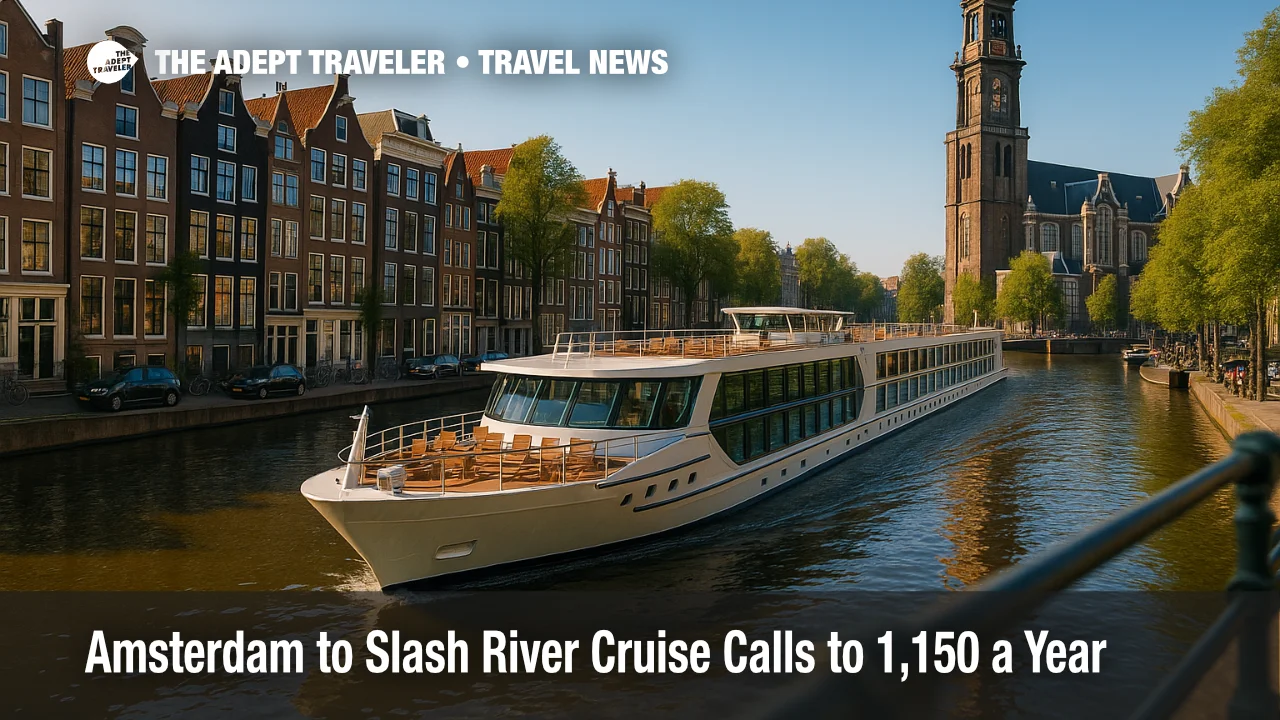Amsterdam to Slash River Cruise Calls to 1,150 a Year

Amsterdam will impose a hard ceiling of 1,150 river-cruise calls per year, down from 1,950 in 2024, as part of a multiyear tourism-management strategy. Cruise operators will receive individual reduction quotas for 2026 based on this year's bookings, while industry group IG RiverCruise negotiates workable windows for docking and passenger transfers. The move dovetails with the Dutch capital's previously announced plan to halve ocean-cruise visits to 100 a year by 2026 and phase the city-center terminal out by 2035.
Key Points
- Why it matters: The cut removes 800 annual ship calls, trimming visitor surges in the historic center.
- Travel impact: Lines will re-tool itineraries, and peak-season berth space will become scarce.
- What's next: IG RiverCruise and city officials aim to finalise a time-slot model by early 2026.
- Enforcement timeline, shore-power rules, and heavier tourist taxes remain under discussion.
- Operators warn of lost economic output but concede quotas are "manageable."
Snapshot
Under the new ordinance Amsterdam will issue each river-cruise brand an annual berth quota built on its 2025 booking footprint. The reduction targets a 41 percent cut in vessel calls compared with 2019 peaks and coincides with broader crowd-control tactics such as phasing out bachelor-party marketing, restricting new hotels, and converting vacant properties to housing. According to IG RiverCruise, river-cruise passengers account for roughly two percent of Amsterdam's visitors yet inject about $257 million in direct local spending. Board member Robbert Verbeek argues ships are "managed tourism suppliers" that can align with the city's liveability goals.
Background
Amsterdam recorded more than 10 million overnight visitors in 2019, a figure city leaders consider unsustainable. Post-pandemic demand rebounded swiftly, prompting stepped-up measures that include the "Stay Away" campaign targeting nuisance partygoers and a 12.5 percent lodging tax. In July 2024 the council voted to relocate the Passenger Terminal Amsterdam and cap ocean-cruise calls at 100 per year from 2026, citing emissions and congestion concerns. The new river-cruise ceiling extends that policy inland. City research shows each docked river ship can pour several hundred day-trippers into already crowded canal zones at once, overwhelming narrow streets and tram lines.
Latest Developments
Industry forms data-sharing task force
IG RiverCruise has launched a working group with municipal staff to map daily flow patterns and propose slot-allocation software similar to airport runway scheduling. Verbeek says operators could cluster arrivals outside rush hours, keep stays short, and use shore power exclusively to minimise emissions. The association seeks flexibility for winter Christmas-market cruises, which boost local retailers during the shoulder season. City officials, meanwhile, insist the 1,150-call figure is non-negotiable but hint at possible exemptions for ships embarking or debarking passengers at airports outside the core.
Analysis
Amsterdam's plan should significantly smooth peak-season footfall in sensitive zones like the Red Light District and Damrak, yet economic trade-offs loom. River ships deliver high-spending, typically older travelers who dine ashore and visit museums but rarely stay overnight. Cutting 41 percent of calls could cost attractions and guides tens of millions annually, though hoteliers may see little effect. Crucially, the quota attacks a manageable sector rather than the far larger Airbnb and day-trip markets, which remain difficult to police. Success will hinge on rigorous berth-allocation transparency and coordination across the Rhine-Main-Danube network; if ships merely swap Amsterdam for nearby ports such as Hoorn or Haarlem the crowding may migrate rather than disappear. Still, Amsterdam's bold stance may set a European precedent, joining Venice and Juneau in treating cruise traffic as one lever among many to balance resident livability with tourism revenue. Travelers should expect higher per-diem cruise pricing and tighter booking windows, particularly for tulip-season voyages.
Final Thoughts
Amsterdam's forthcoming river-cruise cap signals a decisive shift toward visitor-volume governance rather than open-door promotion. Lines able to adapt schedules, electrify vessels, and coordinate passenger dispersal will retain coveted slots, while late movers risk losing access altogether. For travelers, booking early and considering off-season itineraries will be essential in the age of the Amsterdam river cruise cap.
